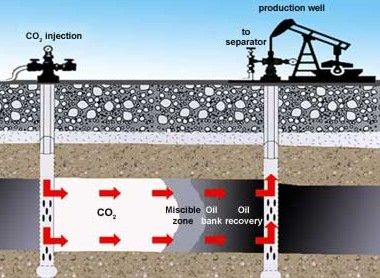Oil Field Extension
Hawkins Oil Field
Exxon Mobil Corporation announced Wednesday (13-Jan-2010) a project to recover additional oil and natural gas in the Hawkins Field in northeast Texas. It predicts the project will produce about 40 million barrels of oil equivalent, extending the life of the field, discovered by ExxonMobil in 1940, for an additional 25 years.
The company will reinject nitrogen and other gases from the field's natural gas production that will enable more oil and gas to be recovered from the reservoirs, the company said. The reinjection of these gases will reduce the plant's air emissions by almost one-third, the company said. Construction of the new facilities is expected to begin in the first quarter of this year. Project start-up is anticipated in late 2011.
The Hawkins Field is located in Wood County, Texas, about 100 miles east of Dallas. Over the past 70 years, it has produced more than 800 million barrels of oil and is one of the largest ever discovered in Texas, the company said.
Gas Injection
 Gas injection is presently the most-commonly used approach to enhanced oil recovery (EOR). A gas is injected into the oil-bearing stratum under high pressure. That pressure pushes the oil into the pipe and up to the surface. In addition to the beneficial effect of the pressure, this method sometimes aids recovery by reducing the viscosity of the crude oil as the gas mixes with it. Gases commonly used include CO2, natural gas or nitrogen. Oil displacement by carbon dioxide injection relies on the phase behaviour of the mixtures of that gas and the crude, which are strongly dependent on reservoir temperature, pressure and crude oil composition. In these applications, more than half and up to two-thirds of the injected CO2 returns with the produced oil and is usually re-injected into the reservoir to minimize operating costs. The remainder is trapped in the oil reservoir by various means.
Gas injection is presently the most-commonly used approach to enhanced oil recovery (EOR). A gas is injected into the oil-bearing stratum under high pressure. That pressure pushes the oil into the pipe and up to the surface. In addition to the beneficial effect of the pressure, this method sometimes aids recovery by reducing the viscosity of the crude oil as the gas mixes with it. Gases commonly used include CO2, natural gas or nitrogen. Oil displacement by carbon dioxide injection relies on the phase behaviour of the mixtures of that gas and the crude, which are strongly dependent on reservoir temperature, pressure and crude oil composition. In these applications, more than half and up to two-thirds of the injected CO2 returns with the produced oil and is usually re-injected into the reservoir to minimize operating costs. The remainder is trapped in the oil reservoir by various means.Using EOR, 30-60 %, or more, of the reservoir's original oil can be extracted compared with 20-40% using primary and secondary recovery.
Costs and Benefits
Adding oil recovery methods adds to the cost of oil — in the case of CO2 typically between 0.5-8.0 US$ per tonne of CO2. The increased extraction of oil on the other hand, is an economic benefit with the revenue depending on prevailing oil prices. Onshore EOR has paid in the range of a net 10-16 US$ per tonne of CO2 injected for oil prices of 15-20 US$/barrel. Prevailing prices depend on many factors but can determine the economic suitability of any procedure, with more procedures and more expensive procedures being economically viable at higher prices. Example: With oil prices at around 130 US$/barrel, the economic benefit is about 100 US$ per tonne CO2.
Citations and References: Exxon to Upgrade Hawkins Oil Field in East Texas to 40 Million Barrels
ExxonMobil Extends Life Of Texas Field, Enhanced oil recovery